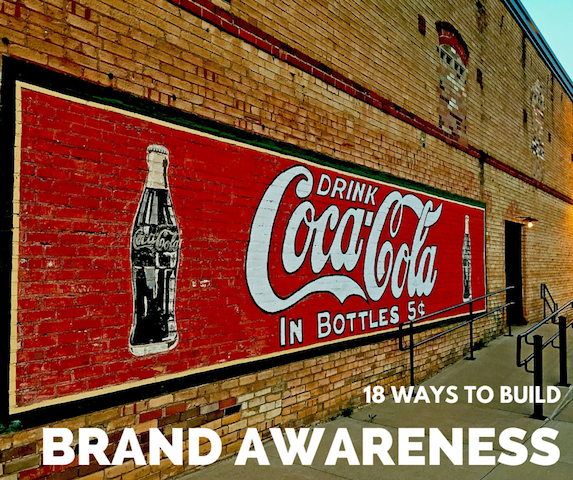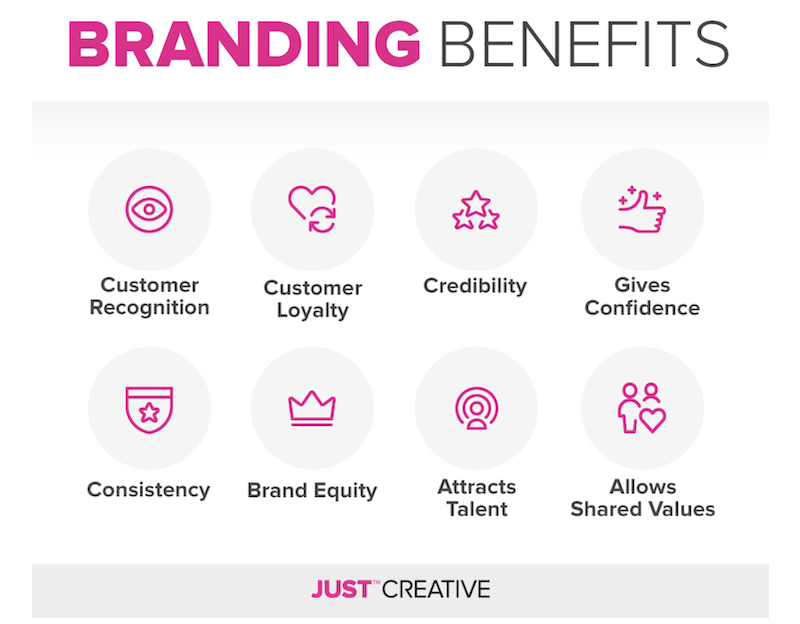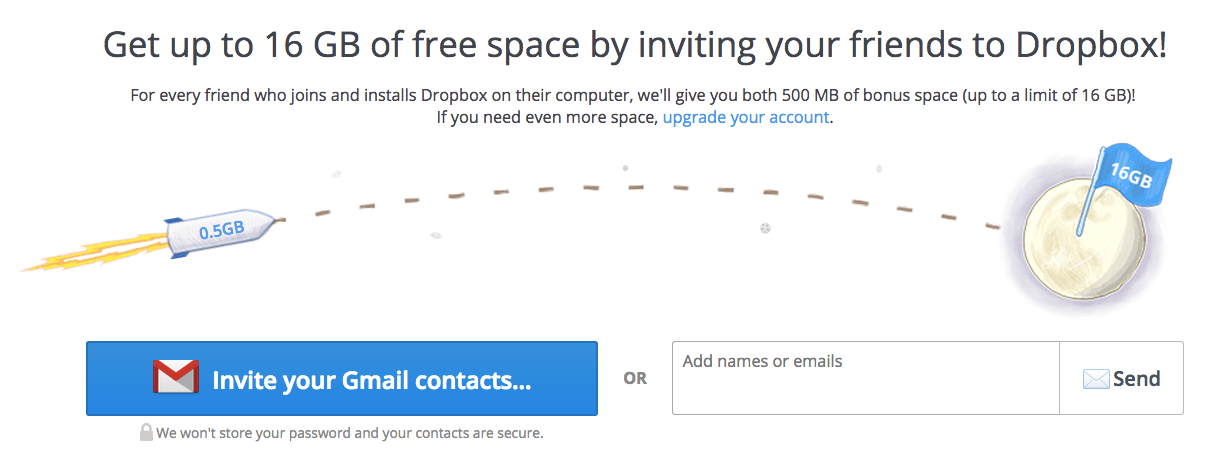When you need a tissue, do you ask for a tissue, or for a Kleenex? When you’re ordering a drink at a fast-food restaurant, do you ask for a cola, or a Coke? What about when you cut yourself? Do you look for a plastic bandage, or a Band-Aid?
These terms are known as proprietary eponyms, and they’re the apex of brand awareness. These brands have become so well-known, they’ve replaced the generic terms for similar products in our language.

For a brand or product to become a proprietary eponym is pretty much the pinnacle of brand awareness (sorry, Pepsi). Although you might not achieve this with your small business, that doesn’t mean you can’t do a lot more to boost awareness of your brand. So in this post, we’re going to equip you to do just that. We’ll cover:
- What brand awareness is and how it compares to brand recognition.
- The importance of brand awareness in achieving your marketing goals.
- Strategies and real examples of successful brand building.
Brand awareness is the extent to which a brand is recognized by potential customers and correctly associated with its particular product or service. In the case of a small business, their level of brand awareness may not reach eponym status (e.g. asking for a Kleenex instead of a tissue), but simpler forms are counted as success. This could mean:
- Consumers having knowledge of what your business is known for.
- A social media user knowing your ad is going to be funny when they come across you in their feed.
- Customers choosing your brand specifically over others, even if there are cheaper options.
- Search engine users typing your business name or other branded terms into search.
ThriveHive is now a part of the WordStream family, but you can see in the example below that one of the top queries that led to their site traffic was their brand name. This is good brand awareness.
When your consumers have brand awareness, they often learn more about your business because they know it exists and are actively seeking out information on it, rather than discovering it in a Google or Yelp search.
Brand recognition vs brand awareness
Brand recognition is the extent to which a consumer can correctly identify your brand based on visual indicators such as logo and colors. For example, if you see the Dunkin Donuts pink and orange letters up ahead, before even making out the words, you’d automatically recognize it as Dunkin Donuts.
Brand awareness takes brand recognition a step further. It involves recalling not only the business name (ideas for creative business names here!), but also the general feeling of the business, information about its products and services, and other experiential details. When a business has a level of brand awareness, their marketing and advertising campaigns mean something to their audience. They elicit feelings and emotions in the consumer.
Brand awareness is all about what the mind state your ideal clients enter when they see or hear your company’s name.
The importance of brand awareness
No matter the quality of your products and services, no matter how much you spend on advertising, and no matter how much you post to social media, your business isn’t likely to get very far if it doesn’t have a brand to set itself apart. Your brand packages up your company name, logo, offerings, and content into an experience for your audience and customers. It is the aspect of businesses that consumers come to trust, that places businesses ahead of their competitors.
Yet simply having a brand is not enough. It’s important to be consistently building that brand and strengthening its associations in the minds of your target audience. The more familiar people are with something, the more they trust it and gravitate to it. The more familiar your target audience is iwth your brand, the easier it will be to:
- Promote your business across multiple channels.
- Successfully introduce new products or services.
- Build a strong business reputation.
- Find and retain loyal customers.
As you can see, brand awareness is important because it helps pave the way for achieving a variety of your small business marketing goals and objectives like staying ahead of the competition, building an audience, and generating more leads. So how do you build a level of brand awarenes that facilitates this kind of success?
How to build brand awareness
Sure, you can plaster your business name on every billboard in town, but most business owners don’t have the budget for high-priced advertising. Plus, increased exposure doesn’t necessarily equate to increased brand awareness. For some simpler yet effective ways of building brand awareness, you may want to:
- Create a custom hashtag for Instagram.
- Participate in or sponsor local events.
- Post regularly to social media using your brand voice.
- Run display ads on the Google Display Network
In addition to the Kleenex and Dunkin Donuts examples above, here are some more companies that have a high level of brand awareness.
- Coca Cola
- Johnson & Johnson
- Visa
- Nike
Most people can identify these brands and feel their unique atmospheres from merely catching a quick glance at their logo or a snippet of their jingle. Using eye-catching visuals, adertising in the right places, and developing a distinct voice in your content, you too can build brand awareness for your company. The key is to be consistent so that you can strengthen your image in the eyes of your audience with every encounter.
The key is to be consistent so that you can strengthen your image in the eyes of your audience with every encounter.
To effectively execute on your strategy, be sure to identify ways of measuring your brand awareness so that you can make necessary adjustments and improvements along the way.
Strategies and examples of building brand awareness
Traditionally, online marketers use the display network to build brand awareness. You can generate thousands of affordable impressions on Display, and when you create enticing display ads (say, by using our Smart Ads Creator), you give yourself a good chance of generating affordable clicks as well. But today, we’re going to talk about some brand building techniques that you can use aside from or conjunction with the display network.
While there’s no quick fix for becoming a household name, here are 18 brand-building strategies to help launch (and continue) your efforts. You may not become as well-known as Coca-Cola, but it can’t hurt to try, right?
Here are our best pieces of brand-building advice.
1. Referral programs
Users will gladly spread word of your product or service when they know they’ll get an added perk. Dropbox is a great example of how smart referral programs can growth hack a business. Dropbox gives existing users 500 MB of extra storage space for every friend they refer (up to 16 GB). Back when Dropbox was still new, this referral program helped generate tons of word-of-mouth, delivering a huge number of sign-ups and saving Dropbox countless advertising dollars.
2. Impressive guest content
Another great way to get your brand known on the web is to deliver ultra valuable, gorgeous looking content to share on other blogs. Guest posting (despite what some might tell you) is still a powerful way to get your name known in your industry.
However, run-of-the-mill content won’t cut it – you need to be guest publishing high-quality stuff. Create memorable, valuable content and you’ll be introduced to new audiences and make a lasting impression.
Brand awareness is the extent to which a brand is recognized by potential customers and correctly associated with its particular product or service. In the case of a small business, their level of brand awareness may not reach eponym status (e.g. asking for a Kleenex instead of a tissue), but simpler forms are counted as success. This could mean:
- Consumers having knowledge of what your business is known for.
- A social media user knowing your ad is going to be funny when they come across you in their feed.
- Customers choosing your brand specifically over others, even if there are cheaper options.
- Search engine users typing your business name or other branded terms into search.
ThriveHive is now a part of the WordStream family, but you can see in the example below that one of the top queries that led to their site traffic was their brand name. This is good brand awareness.
When your consumers have brand awareness, they often learn more about your business because they know it exists and are actively seeking out information on it, rather than discovering it in a Google or Yelp search.
Brand recognition vs brand awareness
Brand recognition is the extent to which a consumer can correctly identify your brand based on visual indicators such as logo and colors. For example, if you see the Dunkin Donuts pink and orange letters up ahead, before even making out the words, you’d automatically recognize it as Dunkin Donuts.
Brand awareness takes brand recognition a step further. It involves recalling not only the business name (ideas for creative business names here!), but also the general feeling of the business, information about its products and services, and other experiential details. When a business has a level of brand awareness, their marketing and advertising campaigns mean something to their audience. They elicit feelings and emotions in the consumer.
Brand awareness is all about what the mind state your ideal clients enter when they see or hear your company’s name.
The importance of brand awareness
No matter the quality of your products and services, no matter how much you spend on advertising, and no matter how much you post to social media, your business isn’t likely to get very far if it doesn’t have a brand to set itself apart. Your brand packages up your company name, logo, offerings, and content into an experience for your audience and customers. It is the aspect of businesses that consumers come to trust, that places businesses ahead of their competitors.
Yet simply having a brand is not enough. It’s important to be consistently building that brand and strengthening its associations in the minds of your target audience. The more familiar people are with something, the more they trust it and gravitate to it. The more familiar your target audience is iwth your brand, the easier it will be to:
- Promote your business across multiple channels.
- Successfully introduce new products or services.
- Build a strong business reputation.
- Find and retain loyal customers.
As you can see, brand awareness is important because it helps pave the way for achieving a variety of your small business marketing goals and objectives like staying ahead of the competition, building an audience, and generating more leads. So how do you build a level of brand awarenes that facilitates this kind of success?
How to build brand awareness
Sure, you can plaster your business name on every billboard in town, but most business owners don’t have the budget for high-priced advertising. Plus, increased exposure doesn’t necessarily equate to increased brand awareness. For some simpler yet effective ways of building brand awareness, you may want to:
- Create a custom hashtag for Instagram.
- Participate in or sponsor local events.
- Post regularly to social media using your brand voice.
- Run display ads on the Google Display Network
In addition to the Kleenex and Dunkin Donuts examples above, here are some more companies that have a high level of brand awareness.
- Coca Cola
- Johnson & Johnson
- Visa
- Nike
Most people can identify these brands and feel their unique atmospheres from merely catching a quick glance at their logo or a snippet of their jingle. Using eye-catching visuals, adertising in the right places, and developing a distinct voice in your content, you too can build brand awareness for your company. The key is to be consistent so that you can strengthen your image in the eyes of your audience with every encounter.
The key is to be consistent so that you can strengthen your image in the eyes of your audience with every encounter.
To effectively execute on your strategy, be sure to identify ways of measuring your brand awareness so that you can make necessary adjustments and improvements along the way.
Strategies and examples of building brand awareness
Traditionally, online marketers use the display network to build brand awareness. You can generate thousands of affordable impressions on Display, and when you create enticing display ads (say, by using our Smart Ads Creator), you give yourself a good chance of generating affordable clicks as well. But today, we’re going to talk about some brand building techniques that you can use aside from or conjunction with the display network.
While there’s no quick fix for becoming a household name, here are 18 brand-building strategies to help launch (and continue) your efforts. You may not become as well-known as Coca-Cola, but it can’t hurt to try, right?
Here are our best pieces of brand-building advice.
1. Referral programs
Users will gladly spread word of your product or service when they know they’ll get an added perk. Dropbox is a great example of how smart referral programs can growth hack a business. Dropbox gives existing users 500 MB of extra storage space for every friend they refer (up to 16 GB). Back when Dropbox was still new, this referral program helped generate tons of word-of-mouth, delivering a huge number of sign-ups and saving Dropbox countless advertising dollars.
2. Impressive guest content
Another great way to get your brand known on the web is to deliver ultra valuable, gorgeous looking content to share on other blogs. Guest posting (despite what some might tell you) is still a powerful way to get your name known in your industry.
However, run-of-the-mill content won’t cut it – you need to be guest publishing high-quality stuff. Create memorable, valuable content and you’ll be introduced to new audiences and make a lasting impression.







